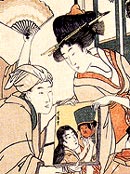

Shunkôsai Hokushû (春好齋北洲)Little is known about the life of the masterful Osaka print designer, painter, and book illustrator Shunkôsai Hokushû (春好齋北洲), active circa 1802–32). He appears to have made a living as a businessman (possibly as a lumber or paper merchant). Exemplifying the skilled amateur ukiyo-e artist of nineteenth-century Osaka, he created rarefied images of kabuki actors while relying on something other than print design for his primary livelihood. He participated in poetry clubs (haikai and kyôka) and was a kabuki enthusiast, with membership in at least one fan club. Most important, he was the leading actor-print designer of his generation.
He used five signatures over the course of his career: Shunkô (春好), from 1/1802 until 1/1818; Shunkôsai (春好齋) alone from 8/1809, or in tandem with Hokushû (北洲) from 1/1818; Shôkôsai (his teacher's art name) for only one print in 9/1811, on which he includes aratame ("changing to") announcing the name change to Shôkôsai (II); Sekkatei (雪花亭) in 1819 as a proofing copyist for an ehon by Katsushika Hokusai (Denshin kaishu Hokusai gashiki) and in 1822 on two single-sheet prints; and Hokushû (北洲) alone from 1/1818 until the end of his career. He also used two literary names: Shikan (until 11/1825, 芝翫) and Baigyoku (11/1825–7/1838, 梅玉) that appear, for instance, with poems inscribed on prints. Hokushû was productive but not prolific, given his thirty-year career. He can be credited with at least 214 surviving single-sheet prints. (He seems to have produced few ehon, woodblock-printed illustrated books.) His first known sheet is a hosoban from 1/1802 with a poem signed by his teacher Shôkôsai. The portrait depicts Otani Tomoemon II as Inokuma Monbei (猪のくま門兵衛) in Keisei kuruwa Genji (けいせい廓源氏) at the Naka Theater, Osaka. There is then a puzzling hiatus from 1802 until 1807, a period for which no prints have surfaced for Hokushû.
Eventually, Hokushû's actors slimmed down as the drawing became more curvilinear, coinciding with the appearance of his "Hokushû" signature, and decidedly so starting in 1820. That same year marked the appearance of Hokushû’s remarkable ôban ôkubi-e ("large-head" or bust portraits: 大首絵), the first in 3/1820, the last in 7/1826 (see image at the top of this page for the example depicting Nakamura Utaemon III (中村歌右衛門) as Gotobei (五斗兵衛) in a production of Yoshitsune Koshigôjô (Yoshitsune’s Koshigôe petition: 義経腰越状), 3/1825, Kado Theater, Osaka, from the series Issei ichidai atari kyôgen (Hit plays of a lifetime: 一世一代当狂言), published by Honsei. A full-frontal portrait such as this was relatively rare both in Osaka and Edo print making. Here, the jôzuri ("top quality" or deluxe: 上摺) printing is remarkable, with extensive use of brass metallics simulating gold and a pair of fierce-looking dragons as a pattern on Utaemon's robe. In his early period, Hokushû collaborated at least 63 times with the monopolistic publisher Shioya Chôbei, from 9/1807 to 1/1819. In his later period, after the breakup of the Shioya publishing hegemony, he worked most often with Honya Seishichi (48 times) and Toshikuraya Shinbei (26 times). The remaining publishers included (in order of frequency) Yamaichi, Arihadô Chûbei, Izutsuya Denbei, Tenmaya Kihei, and Wataya Kihei. Of the many actors portrayed by Hokushû, the luminary Arashi Kichisaburô II (1769-1821) dominated the artist's’s oeuvre until the actor's death in 9/1821 (see hosoban print above). Afterwards, the superstar Nakamura Utaemon III (1778–1838), Kichisaburô II's main rival, appeared in about 76 works with "Hokushû" signatures (not including another 23 or so times during Kichisaburô's lifetime). A much-admired late work by Hokushû is shown below, a portrayal of Nakamura Utaemon III (中村歌右衛門) as the farmer Hyyakushô Gosaku (百姓五作), actually the disguised outlaw Ishikawa Goemon (石川五右衛門) in Keisei setsugekka (Courtesan: Sun, moon, and flowers: けいせい雪月花) at the Kado Theater, Osaka in 1/1830. Osaka's biggest star, Nakamura Utaemon III, not only authored the play under his pen name Kanazawa Ryûgoku, but performed as Ishikawa Goemon opposite Arashi Rikan II's Mashiba Hisatsugu (the historical Toyotomi Hidetsugu, 1568-95). This drama was one of the many tales about the historical and legendary rônin bandit Goemon who, in real life, at the age of sixteen, murdered three men during a robbery. He was finally captured many years later in 1594, when the shogun Toyotomi Hideyoshi (1536-1598) had him boiled in oil. Utaemon is shown performing as Goemon in disguise as a farmer, but he ceases to seem an orthodox salt-of-the-earth figure when one notices the hands — they grip in a gesture associated with necromancy. Here, Goemon summons up ghostly warriors who are barely visible behind the painted stage curtain or scrim, their forms veiled by smoke-like clouds.
Although Hokushû continued to produce single-sheet prints until around 1831-32, there was a steep drop-off after 1825. By then, a new generation of printmakers began to dominate the printmaking market. Some of these artists were students of Hokushû, who had many followers. He tutored twenty-five or more artists, starting as early as 1815, making him one of the most active teachers in all of Osaka printmaking. Among these pupils was the fourth-generation master, Shunbaisai Hokuei. © 2019-2021 by John Fiorillo BIBLIOGRAPHY
|
Viewing Japanese Prints |

_1811_gofukuya_300w.jpg) Hokushû was arguably the finest print artist of his generation, producing an oeuvre that exemplified the third-period development of Osaka printmaking. His earliest prints, in hosoban format, derive partly from
Hokushû was arguably the finest print artist of his generation, producing an oeuvre that exemplified the third-period development of Osaka printmaking. His earliest prints, in hosoban format, derive partly from 